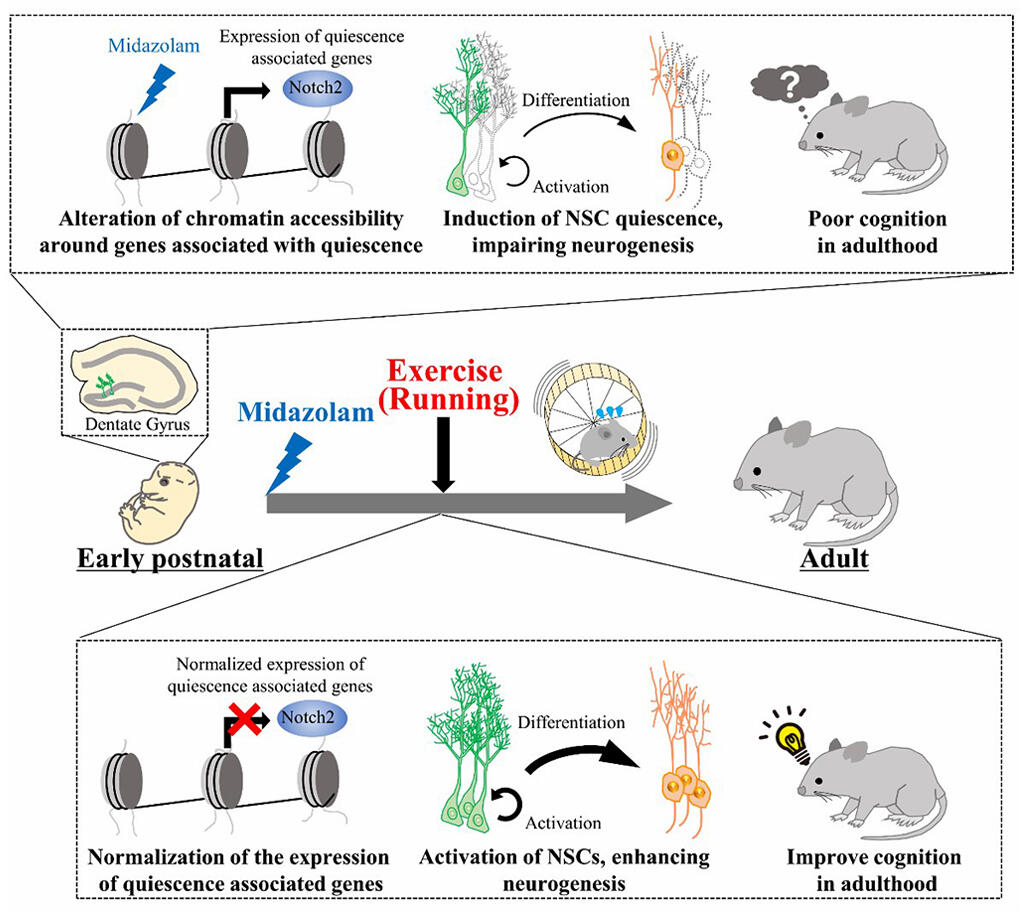Multiple anesthetic exposures in early childhood up to 3 years of age increase the risk of learning/memory impairment and ADHD in adulthood by a factor of 1.75. This phenomenon is well known, and the US FDA issued warnings regarding the issue in 2016 and 2017, but its underlying cause was unknown. A research group consisting of Assistant Professor Hiroyoshi Doi, Assistant Professor Taito Matsuda, and Professor Kinichi Nakashima of the Graduate School of Medicine, Kyushu University, revealed that future learning and memory deficits caused by multiple exposures to anesthetics during development result in difficulty in creating new neurons in the hippocampus of the brain. The researchers also found that spontaneous exercise (such as running) improved these issues in mice models. "I would like to find out whether the improvement with voluntary exercise is sustained or whether it can be improved with drugs rather than exercise," Dr. Nakashima said. "I would also like to study whether it can be applied to humans in cooperation with anesthesiology departments." These findings were published in PNAS.
The research group focused on the neural stem cells present in the hippocampus, and the mechanism of anesthetic-induced learning and memory impairment. Neural stem cells in the hippocampus proliferate and produce new neurons on a daily basis. These newly formed neurons eventually integrate into the hippocampal neural circuits and contribute to the maintenance of learning and memory functions.
Many known anesthetic agents act on GABAA receptors. As neural stem cells express these receptors, multiple exposures to anesthetic during development adversely affect their behavior, and it was hypothesized that multiple exposures would reduce neurogenesis, resulting in impaired cognitive function during adulthood. Midazolam was used in this experiment. It is a widely used anesthetic in children, such as during examinations, induction of anesthesia, sedation in the intensive care unit (ICU), and the treatment of severe epilepsy.
The researcher group sought to clarify the mechanism behind the learning and memory impairment seen in adulthood due to anesthesia exposure during childhood. They exposed developing mice to multiple doses of midazolam (to the extent that a 3-4-hour effect was obtained) to investigate further. Mice that were 7-9 days old were exposed to midazolam once daily for 3 days to investigate the effects on the neural stem cells in the hippocampus at 10 days old and at 8 weeks.
The results showed that the proliferation of neural stem cells in the hippocampus was suppressed from postnatal day 10 through to 8 weeks of age. The researchers also found that a long-term dormant state (quiescence) in neural stem cells led to reduced neurogenesis in adulthood and impaired hippocampus-dependent learning and memory function. Furthermore, comprehensive gene expression analysis of neural stem cells using next-generation sequencers showed that long-term elevated expression of cell dormancy-related genes was involved in inducing long-term dormancy of neural stem cells by anesthetic exposure.
The researchers investigated the chromatin structure of genomic DNA to understand the cause of long-term changes in gene expression. The chromatin state in the vicinity of dormancy-related genes in neural stem cells changes continuously from the developmental to the adult stage. As a result, it was found that the expression of cell dormancy-related genes continued to increase over time.
The researchers found that when running wheels were placed in the cages of mice exposed to midazolam during the developmental stage (4 weeks of age) they ran 5-6 kilometers per day. However, continued exercise until 8 weeks of age resulted in largely normalized expression of the perturbed genes in neural stem cells. "The distance covered, and the number of newborn neurons was proportional. The more they ran, the better. However, if the mice were forced to run, the stress reduced neuron formation" Nakashima reported. In other words, voluntary exercise is important, and the results of behavioral experiments also improved.

(Provided by Kyushu University)
This study showed that anesthetic exposure during the developmental stage contributed to post-adult learning and memory deficits due to decreased neurogenesis caused by forced and long-term neural stem cell dormancy. This long-term cellular dormancy was also caused by long-term elevated expression of cell dormancy-related genes due to chromatin state changes. Previous studies have reported that these effects on the cell occur immediately after anesthetic exposure. However, this study revealed that the effects of anesthetic exposure persist in brain cells for a longer period than previously thought. In addition, this study showed that voluntary exercise (such as running) improves the effects of anesthesia exposure indicating that even if the patient is exposed to anesthesia during the developmental stage, therapeutic intervention may improve learning and memory deficits in the subsequent adult stage.
This article has been translated by JST with permission from The Science News Ltd.(https://sci-news.co.jp/). Unauthorized reproduction of the article and photographs is prohibited.




